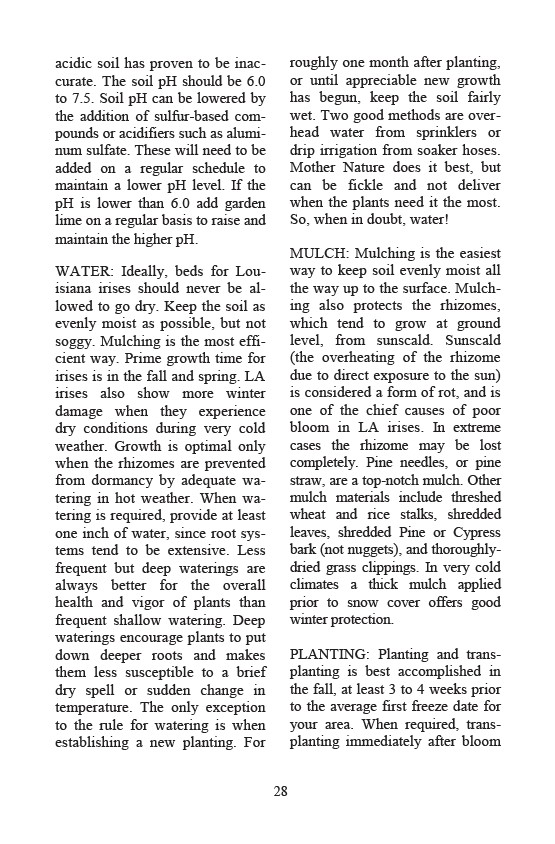
28
acidic soil has proven to be inac-curate.
The soil pH should be 6.0
to 7.5. Soil pH can be lowered by
the addition of sulfur-based com-pounds
or acidifiers such as alumi-num
sulfate. These will need to be
added on a regular schedule to
maintain a lower pH level. If the
pH is lower than 6.0 add garden
lime on a regular basis to raise and
maintain the higher pH.
WATER: Ideally, beds for Lou-isiana
irises should never be al-lowed
to go dry. Keep the soil as
evenly moist as possible, but not
soggy. Mulching is the most effi-cient
way. Prime growth time for
irises is in the fall and spring. LA
irises also show more winter
damage when they experience
dry conditions during very cold
weather. Growth is optimal only
when the rhizomes are prevented
from dormancy by adequate wa-tering
in hot weather. When wa-tering
is required, provide at least
one inch of water, since root sys-tems
tend to be extensive. Less
frequent but deep waterings are
always better for the overall
health and vigor of plants than
frequent shallow watering. Deep
waterings encourage plants to put
down deeper roots and makes
them less susceptible to a brief
dry spell or sudden change in
temperature. The only exception
to the rule for watering is when
establishing a new planting. For
roughly one month after planting,
or until appreciable new growth
has begun, keep the soil fairly
wet. Two good methods are over-head
water from sprinklers or
drip irrigation from soaker hoses.
Mother Nature does it best, but
can be fickle and not deliver
when the plants need it the most.
So, when in doubt, water!
MULCH: Mulching is the easiest
way to keep soil evenly moist all
the way up to the surface. Mulch-ing
also protects the rhizomes,
which tend to grow at ground
level, from sunscald. Sunscald
(the overheating of the rhizome
due to direct exposure to the sun)
is considered a form of rot, and is
one of the chief causes of poor
bloom in LA irises. In extreme
cases the rhizome may be lost
completely. Pine needles, or pine
straw, are a top-notch mulch. Other
mulch materials include threshed
wheat and rice stalks, shredded
leaves, shredded Pine or Cypress
bark (not nuggets), and thoroughly-dried
grass clippings. In very cold
climates a thick mulch applied
prior to snow cover offers good
winter protection.
PLANTING: Planting and trans-planting
is best accomplished in
the fall, at least 3 to 4 weeks prior
to the average first freeze date for
your area. When required, trans-planting
immediately after bloom